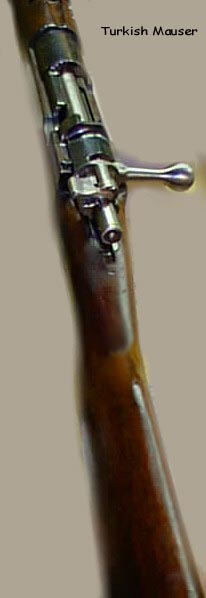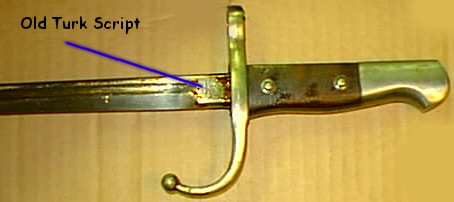
The
Rifles of Turkey 1914 to 1915

by
Dan Reynolds
On the eve of World War One, the Ottoman
Empire was in the advanced stages of decay. The Sultan was the nominal
head of this cosmopolitan empire which had experienced numerous revolts
and wars for the preceding century as nationalist sentiment had flared
between disaffected subject ethnic groups and major powers had seized lands
from the so called "sick man of Europe.”
The "Young Turk" revolt of 1909 displaced
the old Sultan Abdul Hamid Kahn and attempted to introduce liberal reforms
to modernize and preserve the Empire in the face of constant losses.
Especially in Albania the reforms proved counter productive. German
advisers were brought in to help improve the Army. Despite
this, a series of defeats to Italy and then to the allied Balkan states
followed and large numbers of rifles were lost or rendered unserviceable
as a result.
The rifles available to arm Ottoman troops,
police and Muslim militia forces included the Snider type conversions of
caplock Enfields to cartridge firing 14.5mm breech loaders, both rifle
and half stock carbines, Peabody and improved Peabody -Martini .45 Turk
single shot rifles, black powder M1887 Mauser tube magazine 9.5mm rifles
and carbines, five shot Mauser box magazine M1890 7.65mm rifles and carbines,
Mauser M1893 7.65mm rifles with magazine cut offs fitted, 98 type Mauser
M1903 7.65mm rifles and M1905 7.65mm Mauser carbines. A small
number of Steyr 6.5x55mm Norwegian Krag carbines were rumored to have been
acquired around 1904 to arm the Sultan Abdul Hamid Kahn's mounted bodyguard.
He was a gun buff and wanted the Turkish Cavalry to adopt this weapon,
but the 1905 Mauser was selected. Perhaps 200-300 Krags were obtained.
Small quantities of Mannlicher rifles and carbines, M88/90,
M94 and M95 in 8x50mm, M93, 6.5x54mm, M1903 Mannlicher Schonauer, and various
Serbian Mausers were taken in the course of the Balkan Wars.
Some Egyptian 11mm Remingtons were on issue in Arabia.
In June of 1913, the Sultan's Grand Vizir
requested that the Kaiser of German send a Military Mission of German
officers headed by a leading German General Officer to Turkey to reorganize
the Ottoman Army. In November, General of the Cavalry, Liman
von Sanders, led a mission of forty-two officers to Constantinople to undertake
the task. The Turkish Navy was being assisted by a British Naval
Mission under Admiral Limpus, RN. The Imperial Military Police
were 80,000 strong and armed with some of the best rifles, under a French
General, as the Ottoman Turks attempted to balance the "Great Powers".
In 1913, the last batch of new Mauser
rifles, Model 1910 in 7.65mm was delivered from Oberndorf.
It was intended to re-equip the army with as many as 300,000 of this pattern
had not the start of the World War cut off deliveries after a small number
had been shipped. According to John Wall’’s research, perhaps only
slightly more than 1,000 of these Mausers were shipped. It
is not known for sure what the official Ottoman model designation for this
series was. They may have been considered M1903, but the date 1910
is rolled on the ring. The rifles delivered had the western commercial
export markings and numbers. The only identifier of Turkish ownership
being the toughra of the deposed Abdul Hamid on the butt of the long bayonet
supplied with these rifles and the old style Turkish script on the blade
near the hilt indicating the date of 1907. These rifles/bayonets
may have been assembled from parts on hand at the factory.
Liman von Sanders was made Marshal and
Inspector General of the Turkish Army as of 14 January 1914. This
did not mean he controlled the Army. The real power in Turkey was
the "Committee" of Young Turks, the names of the actual members being obscure
to outsiders. They installed Enver Pasha as Minister of War and Commander
in Chief of the Army and Enver informed the Sultan after the fact.
A purge of the officer corp ensued eliminating 1100 men, key members being
imprisoned if deemed a threat to the new order. The Germans were
kept out of the loop. The core of the Ottoman Empire was the Anatolian
Turks, but other ethnic groups were represented among the officials and
officer corp, including Bosnians, Albanians and Arabs among others.
The Turkish Army was in poor condition with the troops poorly trained and
clothed, many without shoes, lacking in proper medical care, basic equipment
and especially modern serviceable rifles. In the short period
leading up to the start of war, German officers took over and reorganized
various schools to train officers, were placed on various unit staffs as
advisers, and tried to improve sanitary measures.
When war broke out in August 1914, Turkey
remained neutral. Six Army Groups were established, but most were
mere shadow organizations with infantry companies sometimes numbering 20
rifles. Eventually by 1918, nine Army Groups had been formed,
but these were more form than substances being inadequately manned, armed
and supplied. At the end of October 1914, the German Admiral von
Usedom took command of the defenses along the Dardanelles and the Bosporus
as Turkey entered the war on the side of the Central Powers. Enver
Pasha was pro German and the "Committee", despite some dissent, had approved
Enver's plan to persuade the Grand Vizir to sign, on 2 August, a secret
undertaking to enter any war arising from Germany aiding Austro Hungary
against Russia.
Turkey's entry into the war on the side
of the Central Powers was a great victory for German diplomacy.
Russia declared war on Turkey on 1 November. The French and
British attacked the forts protecting the Dardanelles on 3 November and
declared war on 5 November. The Dardanelles was a narrow strait of
water separating Europe from Asia and gave access to the Sea of Marmara
and Constantinople and the Bosporus and Black Sea. A British force
seized Basra at the head of the Persian Gulf on 21 November, and a plan
evolved to advance up the Tigris River and capture Bagdad, capital of the
Ottoman province of Mesopotamia.
The Turkish forces were ill equipped to
begin a major war and von Sanders tried to get Enver to adopt prudent,
limited action in line with available resources. Enver for geopolitical
reasons wanted to take the offensive on a grand scale and was supported
by certain German officers not attached to von Sander's Mission.
The best armed, trained and supplied troops were the First Army around
Constantinople. These forces were generally fairly up to strength
in manpower. Other Armies were not nearly as well off.
The Third Army in the Caucasus, despite
shortages, met the Russian invasion in November and brought it to a halt.
In December, Enver took personal command of this Army and launched a winter
offensive which ended in disaster, losing more than 80,000 rifles.
By New Year 1915, the Turks had lost some 120,000+ rifles through capture
by the enemy, desertions, theft and damage. Before the war, Germany
had been the main supplier of small arms. Up to now, supplies had
been cut off as Germany needed all the rifles it could muster for her own
forces and shipment was interdicted by Allied control of seas. The
neutrality of Romania, Greece and Bulgaria which made rail shipment not
feasible until Serbia was smashed by Bulgarian entry into the war on the
side of the Central Powers some nine months later.
On February 3, 1915, Turkish forces had
attacked the Suez Canal, but it was only a raid and a withdrawal was ordered
into the Sinai. Arab troops in the Turkish force showed signs
of panic. Troops were armed with 7.65mm Mausers.
At the end of April, the Allies began
the invasion of the Gallipoli peninsula on the Dardanelles. The battle
was to last more than eight and half months. The ANZAC CORP, Australian
and New Zealand troops, were the major Allied component and suffered very
heavy casualties. Liman von Sanders took personal command of the
campaign and the Turk Fifth Army was the major Ottoman army group.
Ammunition was very short on the Turk side while the Allies were very well
supplied with everything from the sea and enjoyed the Big Gun support of
the Royal and French Navies. As Turkish casualties mounted, the Second
Army was sent in at Sedd el Barr on the south front. In September,
Bulgaria entered the war opening a land/rail link from Germany, though
war material did not arrive until November. Late in September, Arab
troops replaced units of the Second Army in the line and they proved to
be inadequate in training and elan. They had to be stiffened by reliable
units and confined to defensive operations.
Supplies of Mosin Nagant M1891 rifles
and ammunition had reached Turkey by late fall 1915. These supplemented
the small numbers the Turks had captured from the Russians. Austria, as
well as Germany may have supplied some of these.
Late in November, Austrian and German
troops arrived in Gallipoli and the Allied position began seeming more
futile to the Allied leadership. On 20 December 1915, under cover
of a dense fog, the Allies withdrew to their ships abandoning a huge amount
of war material. Vickers MG's and S.M.L.E. Enfields and .303
ammunition came into inventory and were issued.

